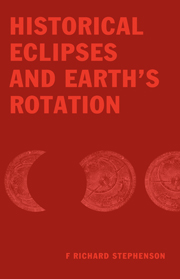Book contents
- Frontmatter
- Contents
- Principal Symbols
- 1 Variations in the length of the day: a historical perspective
- 2 Tidal friction and the ephemerides of the Sun and Moon
- 3 Pre-telescopic eclipse observations and their analysis
- 4 Babylonian and Assyrian records of eclipses
- 5 Investigation of Babylonian observations of solar eclipses
- 6 Timed Babylonian lunar eclipses
- 7 Untimed Babylonian observations of lunar eclipses: horizon phenomena
- 8 Chinese and other East Asian observations of large solar eclipses
- 9 Other East Asian observations of solar and lunar eclipses
- 10 Records of eclipses in ancient European history
- 11 Eclipse records from medieval Europe
- 12 Solar and lunar eclipses recorded in medieval Arab chronicles
- 13 Observations of eclipses by medieval Arab astronomers
- 14 Determination of changes in the length of the day
- Appendix A Timed data
- Appendix B Untimed data
- References
- Acknowledgements
- Index of eclipse records
- Index of places of observation
- Name Index
- Subject index
1 - Variations in the length of the day: a historical perspective
Published online by Cambridge University Press: 13 November 2009
- Frontmatter
- Contents
- Principal Symbols
- 1 Variations in the length of the day: a historical perspective
- 2 Tidal friction and the ephemerides of the Sun and Moon
- 3 Pre-telescopic eclipse observations and their analysis
- 4 Babylonian and Assyrian records of eclipses
- 5 Investigation of Babylonian observations of solar eclipses
- 6 Timed Babylonian lunar eclipses
- 7 Untimed Babylonian observations of lunar eclipses: horizon phenomena
- 8 Chinese and other East Asian observations of large solar eclipses
- 9 Other East Asian observations of solar and lunar eclipses
- 10 Records of eclipses in ancient European history
- 11 Eclipse records from medieval Europe
- 12 Solar and lunar eclipses recorded in medieval Arab chronicles
- 13 Observations of eclipses by medieval Arab astronomers
- 14 Determination of changes in the length of the day
- Appendix A Timed data
- Appendix B Untimed data
- References
- Acknowledgements
- Index of eclipse records
- Index of places of observation
- Name Index
- Subject index
Summary
Introduction
The main purpose of this book is to investigate in detail long-term variations in the length of the day, or equivalently, changes in the Earth's rate of rotation, using pre-telescopic observations of eclipses. Such variations are mainly produced by lunar and solar tides, but non-tidal mechanisms are also significant. Despite its historical bias, this subject has become an important topic in modern geophysics.
In studying changes in the length of the day which have occurred in recent centuries (since the invention of the telescope), more accurate data than eclipses are available. These include occultations of stars by the Moon up to 1955 and systematic monitoring of the Earth's rotation relative to the atomic time-scale since that date. However, observations of eclipses provide by far the most consistent and reliable source of information on variations in the terrestrial rate of rotation during the pre-telescopic period.
Although numerous early accounts of eclipses are to be found in astronomical works, many others are scattered in a variety of writings – for example the Greek and Latin classics, imperial annals of China and monastic chronicles of Europe. Observations recorded in these works are often extremely crude by modern standards, but the lengthy time-scale covered is highly suited to the detection of long-term trends which are not apparent from more recent data. The investigation of this diverse material adds a whole new dimension to what might otherwise have been a somewhat narrow scientific discipline.
- Type
- Chapter
- Information
- Historical Eclipses and Earth's Rotation , pp. 1 - 32Publisher: Cambridge University PressPrint publication year: 1997



